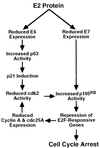Repression of human papillomavirus oncogenes in HeLa cervical carcinoma cells causes the orderly reactivation of dormant tumor suppressor pathways
- PMID: 11070078
- PMCID: PMC18795
- DOI: 10.1073/pnas.97.23.12513
Repression of human papillomavirus oncogenes in HeLa cervical carcinoma cells causes the orderly reactivation of dormant tumor suppressor pathways
Abstract
Most cervical carcinomas express high-risk human papillomaviruses (HPVs) E6 and E7 proteins, which neutralize cellular tumor suppressor function. To determine the consequences of removing the E6 and E7 proteins from cervical cancer cells, we infected HeLa cells, a cervical carcinoma cell line that contains HPV18 DNA, with a recombinant virus that expresses the bovine papillomavirus E2 protein. Expression of the E2 protein resulted in rapid repression of HPV E6 and E7 expression, followed approximately 12 h later by profound inhibition of cellular DNA synthesis. Shortly after E6/E7 repression, there was dramatic posttranscriptional induction of p53. Two p53-responsive genes, mdm2 and p21, were induced with slightly slower kinetics than p53 and appeared to be functional, as assessed by inhibition of cyclin-dependent kinase activity and p53 destabilization. There was also dramatic posttranscriptional induction of p105(Rb) and p107 after E6/E7 repression, followed shortly thereafter by induction of p130. By 24 h after infection, only hypophosphorylated p105(Rb) was detectable and transcription of several Rb/E2F-regulated genes was dramatically repressed. Constitutive expression of the HPV16 E6/E7 genes alleviated E2-induced growth inhibition and impaired activation of the Rb pathway and repression of E2F-responsive genes. This dynamic response strongly suggests that the p53 and Rb tumor suppressor pathways are intact in HeLa cells and that repression of HPV E6 and E7 mobilizes these pathways in an orderly fashion to deliver growth inhibitory signals to the cells. Strikingly, the major alterations in the cell cycle machinery underlying cervical carcinogenesis can be reversed by repression of the endogenous HPV oncogenes.
Figures







References
Publication types
MeSH terms
Substances
Grants and funding
LinkOut - more resources
Full Text Sources
Other Literature Sources
Research Materials
Miscellaneous

